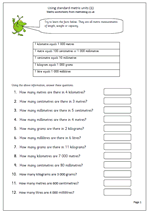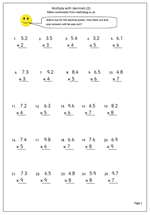 Next week I will be publishing worksheets concentrating on division for years 6, 4 and 3.
Next week I will be publishing worksheets concentrating on division for years 6, 4 and 3.
Firstly, written for Year 6, will be the second of our pages on dividing decimals mentally. Concentrating on just one decimal place it is a good test of how well children know their tables and understand place value.
Coming soon for year 4 is a worksheet which looks for a rapid response from children to show that they clearly understand what is happening when numbers become 10 times or 100 times smaller. All the numbers are multiples of 10 so there is no need to get involved with decimal points.
For year 3 there will be another page that looks at the relationship between division and multiplication and how knowledge of one fact can lead to knowing several other facts. Some children fail to realise that division and multiplication are related, so when it comes to long division later, which involves mostly multiplication, they are lost.








